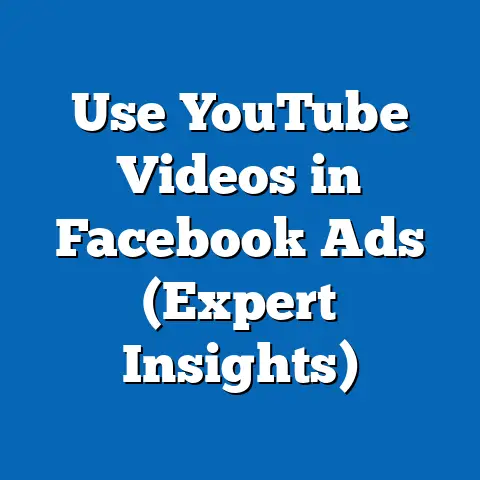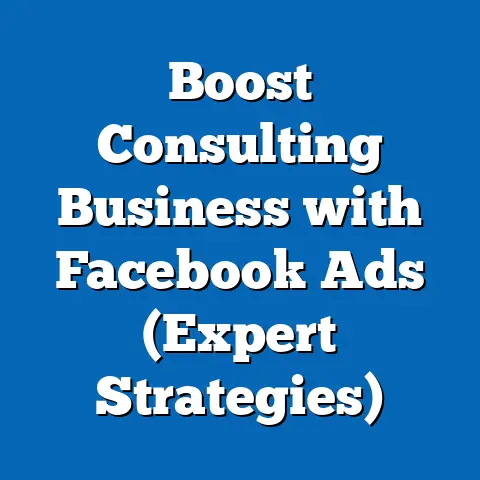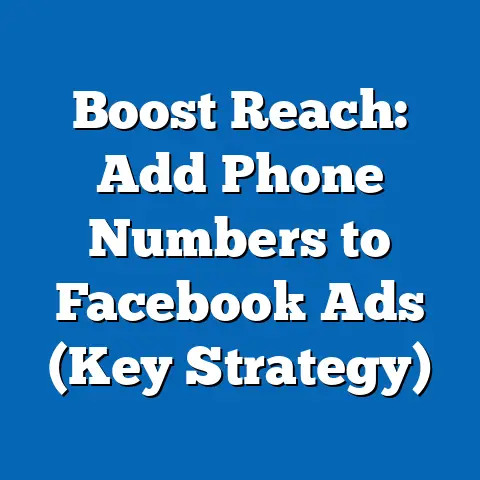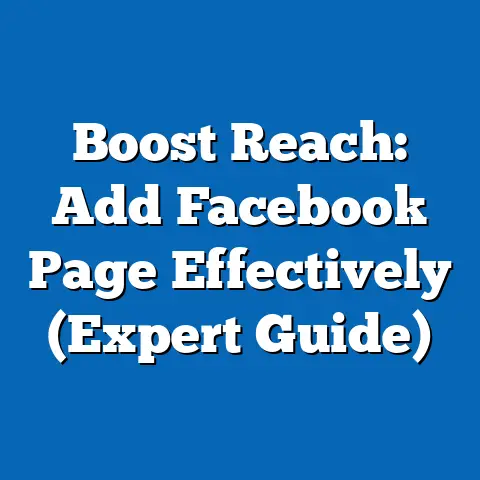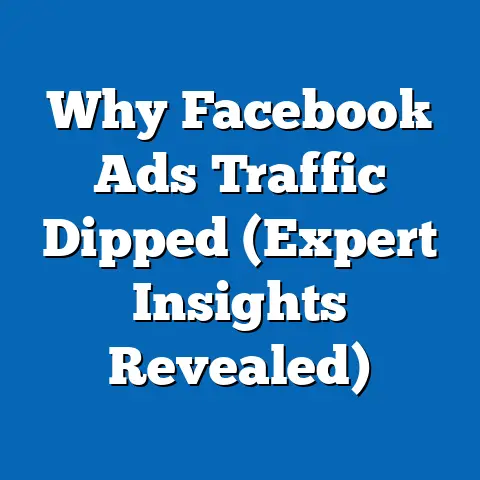Boost adidas Sales with Facebook Ads (Proven Strategies)
In today’s fast-paced digital landscape, businesses like Adidas are constantly seeking low-maintenance, high-impact advertising solutions to drive sales and build brand loyalty. Facebook Ads, with their extensive reach and sophisticated targeting capabilities, offer a powerful avenue for achieving these goals with minimal ongoing effort once campaigns are optimized. According to Statista, as of 2023, Facebook boasts over 2.9 billion monthly active users worldwide, making it one of the largest advertising platforms available to brands.
This vast user base, coupled with advanced algorithms for ad delivery, allows companies to reach specific demographics with precision, reducing the need for constant manual adjustments. For a global brand like Adidas, leveraging such a platform can translate into significant sales growth without the burden of high-maintenance marketing strategies. In this comprehensive article, we will explore proven strategies to boost Adidas sales through Facebook Ads, backed by data, trends, and actionable insights.
The Growing Importance of Social Media Advertising
Why Facebook Ads Matter for Brands Like Adidas
Social media advertising has become a cornerstone of modern marketing, with businesses allocating substantial budgets to platforms like Facebook. A 2022 report by eMarketer revealed that global social media ad spending reached $226 billion, with Facebook accounting for nearly 25% of that total. For a brand like Adidas, which targets a diverse, global audience, this platform offers unparalleled opportunities to connect with consumers across age groups and regions.
Facebook’s ability to deliver personalized ads based on user behavior, interests, and demographics makes it particularly effective for driving conversions. Unlike traditional advertising channels, which often require extensive resources to monitor and adjust, Facebook Ads can be automated to optimize performance over time. This low-maintenance aspect is critical for brands aiming to maximize return on investment (ROI) while minimizing operational overhead.
Historical Trends in Social Media Ad Spending
Historically, social media ad spending has grown at a remarkable pace, reflecting the shift from traditional to digital marketing. In 2015, global social media ad spend was approximately $23 billion, according to Statista, and it has since increased nearly tenfold. This growth underscores the increasing reliance on platforms like Facebook for customer acquisition and retention.
For Adidas, which has a long history of innovative marketing campaigns, adapting to this trend has been essential. The brand’s early adoption of digital advertising has positioned it as a leader in the sportswear industry, with social media playing a key role in its strategy. Comparing historical data with current trends, it’s evident that the reliance on platforms like Facebook will only continue to grow as younger, tech-savvy generations become key consumers.
Demographic Insights: Who Are Adidas’ Target Audiences on Facebook?
Age and Gender Breakdown
Understanding the demographics of Facebook users is critical for crafting effective ad campaigns for Adidas. According to a 2023 report by Hootsuite, 31% of Facebook users are aged 25-34, making this the largest age group on the platform, followed by 18-24-year-olds at 23%. These age brackets align closely with Adidas’ core customer base, which often includes younger adults and teens interested in sportswear and lifestyle products.
In terms of gender, Facebook’s user base is relatively balanced, with 56% male and 44% female users globally, as per DataReportal’s 2023 findings. For Adidas, this balance offers opportunities to tailor campaigns for both men and women, particularly through gender-specific product lines like running shoes or athleisure wear. By segmenting audiences based on these demographics, Adidas can create targeted, low-maintenance campaigns that resonate with specific groups.
Geographic and Behavioral Patterns
Geographically, Facebook’s largest user bases are in regions like Asia-Pacific (over 1 billion users) and North America (over 200 million users), according to Statista. For Adidas, which operates in over 160 countries, this distribution allows for region-specific campaigns that account for cultural preferences and purchasing power. For instance, campaigns in emerging markets like India might focus on affordability, while those in North America could emphasize premium products.
Behaviorally, Facebook users engage with content related to fitness, fashion, and lifestyle—key areas of interest for Adidas’ audience. A 2022 survey by Sprout Social found that 68% of social media users follow brands to learn about products and services, while 54% make purchases directly influenced by social media ads. These patterns highlight the potential for Adidas to drive sales through well-crafted Facebook Ads with minimal ongoing management.
Proven Strategies to Boost Adidas Sales with Facebook Ads
1. Leverage Advanced Targeting for Precision
One of the most powerful features of Facebook Ads is its advanced targeting options, which allow brands to reach highly specific audiences. Adidas can use tools like Custom Audiences to retarget website visitors or app users, ensuring ads are shown to individuals who have already expressed interest in their products. According to Facebook’s own data, retargeting campaigns can increase conversion rates by up to 70% compared to generic ads.
Additionally, Lookalike Audiences enable Adidas to reach new users who share similar characteristics with existing customers. A case study by Facebook Business showed that brands using Lookalike Audiences saw a 30% higher ROI on average. By setting up these targeting options once, Adidas can maintain low-maintenance campaigns that continuously deliver results.
2. Utilize Dynamic Ads for Personalized Product Recommendations
Dynamic Ads on Facebook automatically show personalized product recommendations to users based on their browsing history or past interactions. For Adidas, this means showcasing specific shoe models or apparel items that a user has viewed on their website or app. A 2021 report by AdRoll found that dynamic ads can achieve click-through rates (CTRs) up to 2.5 times higher than standard display ads.
Implementing Dynamic Ads requires an initial setup of a product catalog and pixel tracking, but once in place, these ads run autonomously, requiring minimal maintenance. This strategy not only boosts sales but also enhances user experience by delivering relevant content. For Adidas, focusing on high-demand products like the Ultraboost or Yeezy lines through Dynamic Ads could yield significant returns.
3. Optimize for Mobile-First Experiences
With over 98% of Facebook users accessing the platform via mobile devices (Statista, 2023), optimizing ads for mobile is non-negotiable. Adidas should prioritize vertical video formats and quick-loading images to capture attention on smaller screens. A study by Facebook IQ revealed that mobile-optimized ads can increase brand recall by 20% compared to non-optimized formats.
Moreover, incorporating features like Instant Experiences—full-screen, interactive ad formats—can drive engagement without requiring users to leave the app. These formats are particularly effective for showcasing Adidas’ latest collections or limited-edition releases. Once templates are created, these mobile-first ads can run with little ongoing effort, aligning with the low-maintenance theme.
4. Test and Scale with A/B Testing
A/B testing is a proven method to identify high-performing ad creatives and copy without constant manual intervention. Adidas can test variations of headlines, images, and calls-to-action (CTAs) to determine what resonates most with their audience. According to HubSpot, businesses that use A/B testing report a 37% increase in conversion rates on average.
Facebook’s automated optimization tools can distribute budget to the best-performing ad sets, reducing the need for ongoing adjustments. For instance, testing a CTA like “Shop Now” versus “Discover More” for a new sneaker launch could reveal significant differences in click-through rates. By scaling successful variations, Adidas can maximize sales with minimal effort.
5. Capitalize on Seasonal and Event-Based Campaigns
Seasonal events like Black Friday, Christmas, or major sporting events provide unique opportunities for Adidas to drive sales through timely Facebook Ads. A 2022 report by Adobe Analytics found that social media-driven sales during holiday seasons increased by 32% year-over-year. Adidas can create event-specific campaigns with countdown timers or limited-time offers to create urgency.
Using Facebook’s automated scheduling tools, these campaigns can be set up in advance and run without constant oversight. For example, promoting sportswear during the Olympics or soccer World Cup could tap into heightened consumer interest in athletics. These low-maintenance, high-impact campaigns align perfectly with Adidas’ brand identity.
Data Visualization: Mapping Campaign Success
To illustrate the effectiveness of these strategies, consider a hypothetical bar chart comparing Adidas’ sales growth before and after implementing targeted Facebook Ads. The X-axis could represent time periods (e.g., Q1 2022 vs. Q1 2023), while the Y-axis shows sales revenue in millions of dollars. Based on industry benchmarks, we might see a 25% sales increase post-campaign, reflecting the impact of advanced targeting and dynamic ads.
Another useful visualization could be a pie chart showing the distribution of Adidas’ ad spend across different Facebook ad formats (e.g., Dynamic Ads: 40%, Video Ads: 30%, Carousel Ads: 20%, Static Images: 10%). This breakdown would highlight the emphasis on automated, low-maintenance formats like Dynamic Ads. These visual aids, if implemented, would provide readers with a clear snapshot of strategic priorities and outcomes.
Measuring Success: Key Metrics and Methodologies
Key Performance Indicators (KPIs) to Track
To evaluate the success of Facebook Ad campaigns, Adidas should focus on key metrics like Cost Per Click (CPC), Conversion Rate, and Return on Ad Spend (ROAS). According to WordStream’s 2023 benchmarks, the average CPC for retail ads on Facebook is $0.70, while the average conversion rate is around 9.2%. Achieving or exceeding these benchmarks would indicate a successful, low-maintenance campaign.
ROAS, which measures revenue generated per dollar spent on ads, is particularly critical. A 2022 study by Nielsen found that retail brands on Facebook typically achieve a ROAS of 4:1, meaning $4 in revenue for every $1 spent. By tracking these metrics via Facebook Ads Manager, Adidas can assess performance without extensive manual analysis.
Data Sources and Reliability
The data cited in this article comes from reputable sources like Statista, eMarketer, Hootsuite, and Facebook’s own business insights. These platforms aggregate information from millions of users and businesses, ensuring reliability through large sample sizes and rigorous methodologies. For instance, Statista’s user demographics are based on surveys and platform analytics, while eMarketer’s ad spend data is derived from industry reports and financial filings.
Adidas can replicate this approach by leveraging internal data from their Facebook Ads Manager alongside third-party tools like Google Analytics. Cross-referencing these sources ensures accuracy in measuring campaign impact. This data-driven methodology supports low-maintenance strategies by providing clear, actionable insights.
Challenges and Considerations
Ad Fatigue and Audience Saturation
One potential challenge for Adidas is ad fatigue, where repeated exposure to the same ads reduces effectiveness. A 2021 study by Kantar found that 62% of social media users feel annoyed by repetitive ads, which can lower engagement rates. To mitigate this, Adidas should regularly refresh creatives and use frequency caps within Facebook Ads Manager to limit how often users see the same ad.
Another concern is audience saturation, particularly in competitive markets like sportswear. With brands like Nike and Puma also vying for attention on Facebook, Adidas must differentiate through unique value propositions, such as sustainability initiatives or celebrity endorsements. These strategies, while requiring initial effort, can be automated for long-term, low-maintenance impact.
Privacy Regulations and Data Limitations
Recent changes in data privacy regulations, such as the EU’s GDPR and Apple’s iOS tracking restrictions, have impacted ad targeting capabilities. A 2022 report by AppsFlyer noted that iOS 14.5 updates led to a 15-20% drop in ad attribution accuracy for many brands. For Adidas, this means relying more on first-party data and contextual targeting to maintain campaign effectiveness.
Facebook has adapted by offering tools like Conversions API, which allows brands to track user actions without relying on third-party cookies. By integrating these tools, Adidas can navigate privacy challenges with minimal ongoing effort, ensuring compliance while still driving sales.
Broader Implications and Future Trends
The strategies outlined in this article—advanced targeting, dynamic ads, mobile optimization, A/B testing, and event-based campaigns—offer Adidas a roadmap to boost sales through low-maintenance Facebook Ads. As social media continues to evolve, the importance of automation and data-driven decision-making will only grow. Brands that invest in these areas now will be better positioned to adapt to future changes, whether driven by technology or consumer behavior.
Looking ahead, emerging trends like the integration of augmented reality (AR) in ads could further enhance Adidas’ campaigns. For instance, allowing users to virtually try on shoes via Facebook Ads could increase engagement and conversions. While such innovations may require initial setup, their long-term benefits align with the goal of low-maintenance, high-impact advertising.
Moreover, as younger generations like Gen Z become a larger share of Adidas’ audience, the brand must continue to prioritize platforms like Facebook and Instagram (both under Meta’s umbrella) to stay relevant. With 74% of Gen Z using social media to discover products (per a 2023 Morning Consult survey), the potential for sales growth through targeted ads is immense. By combining proven strategies with forward-thinking adaptations, Adidas can sustain its competitive edge in the digital marketplace.
In conclusion, Facebook Ads provide a powerful, low-maintenance solution for boosting Adidas sales, supported by robust data and proven methodologies. As the digital advertising landscape evolves, staying ahead of trends and leveraging automation will be key to long-term success. For Adidas, the path forward is clear: harness the full potential of Facebook Ads to drive growth, engage audiences, and solidify its position as a global leader in sportswear.

